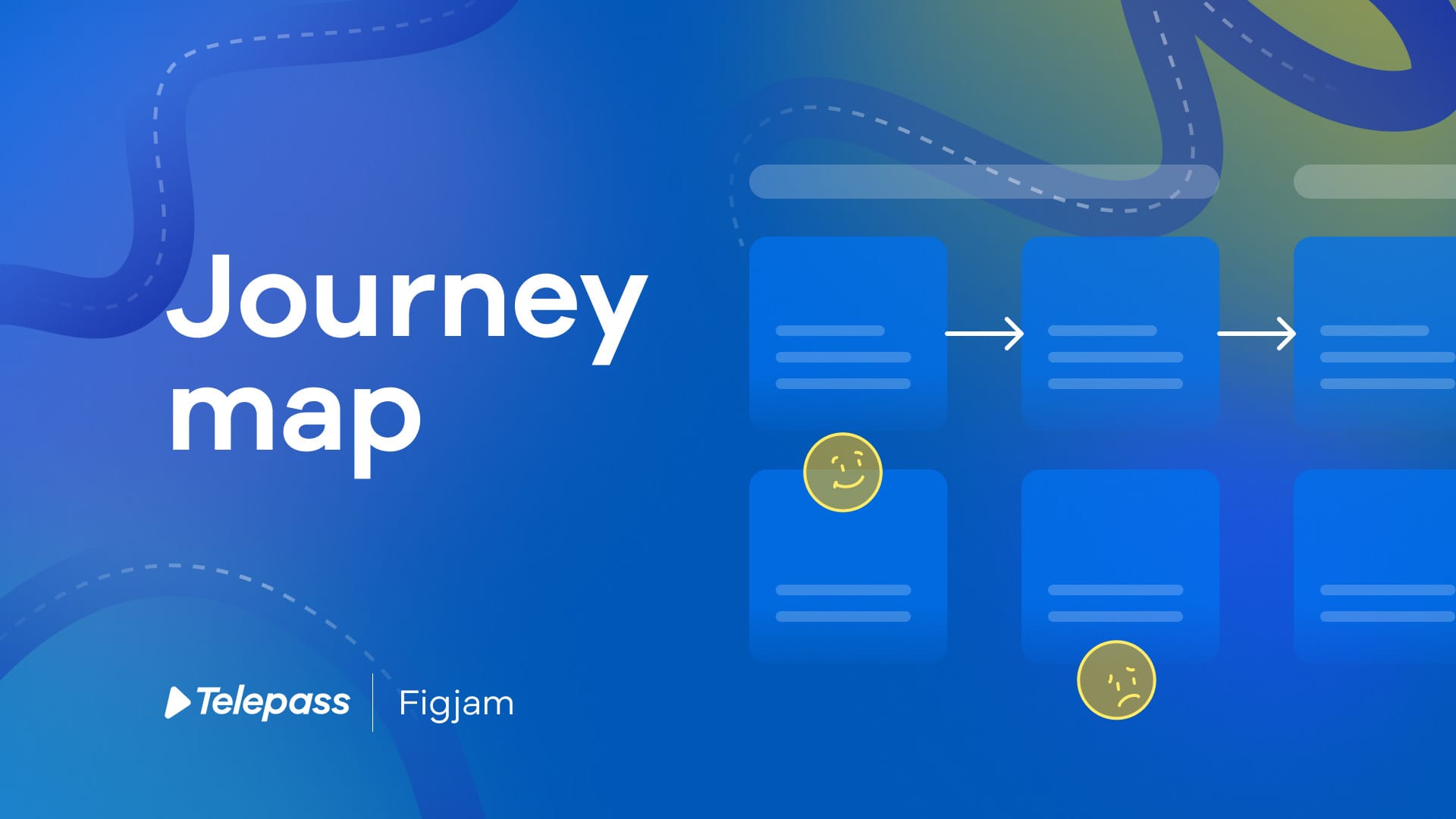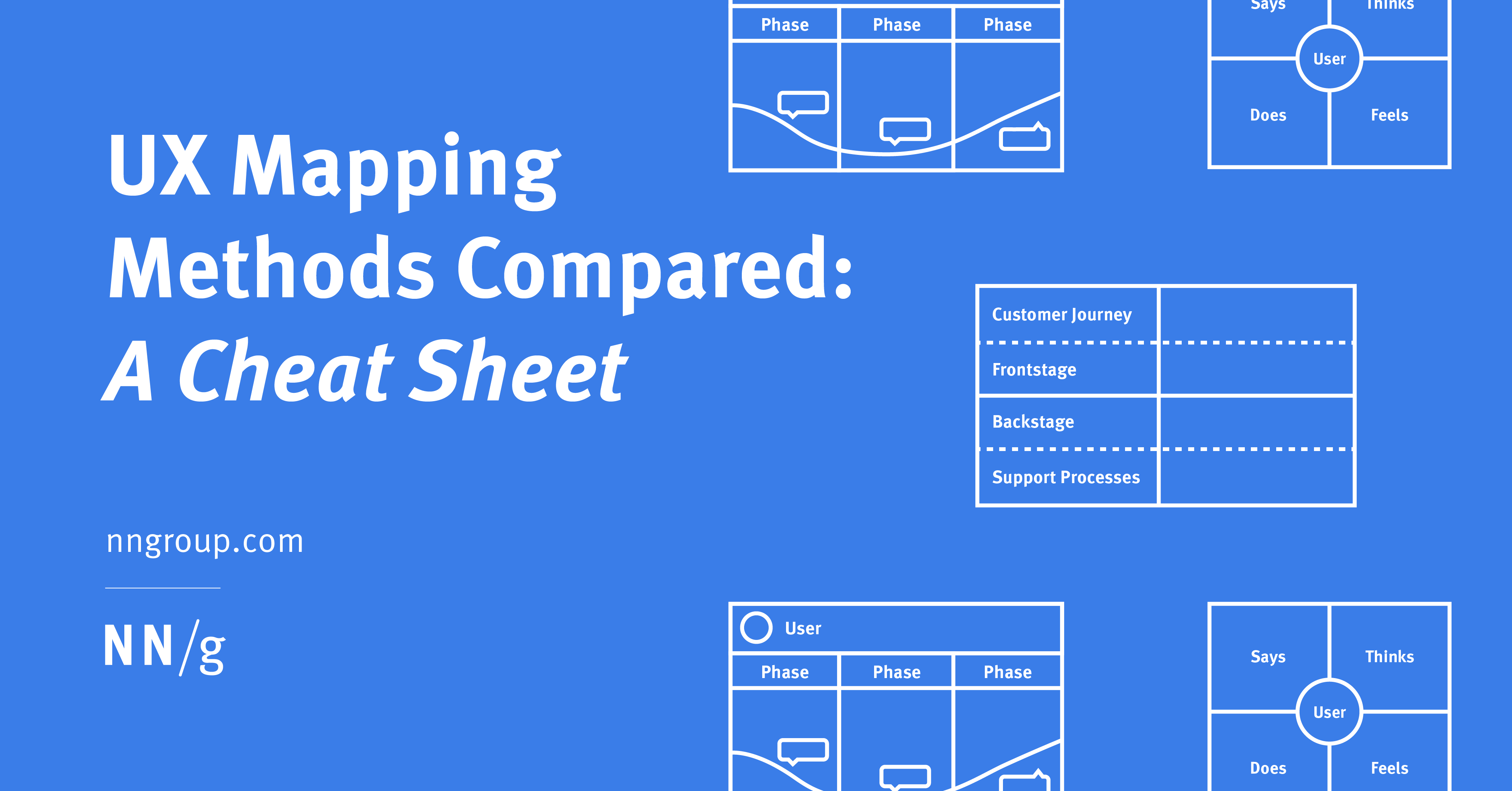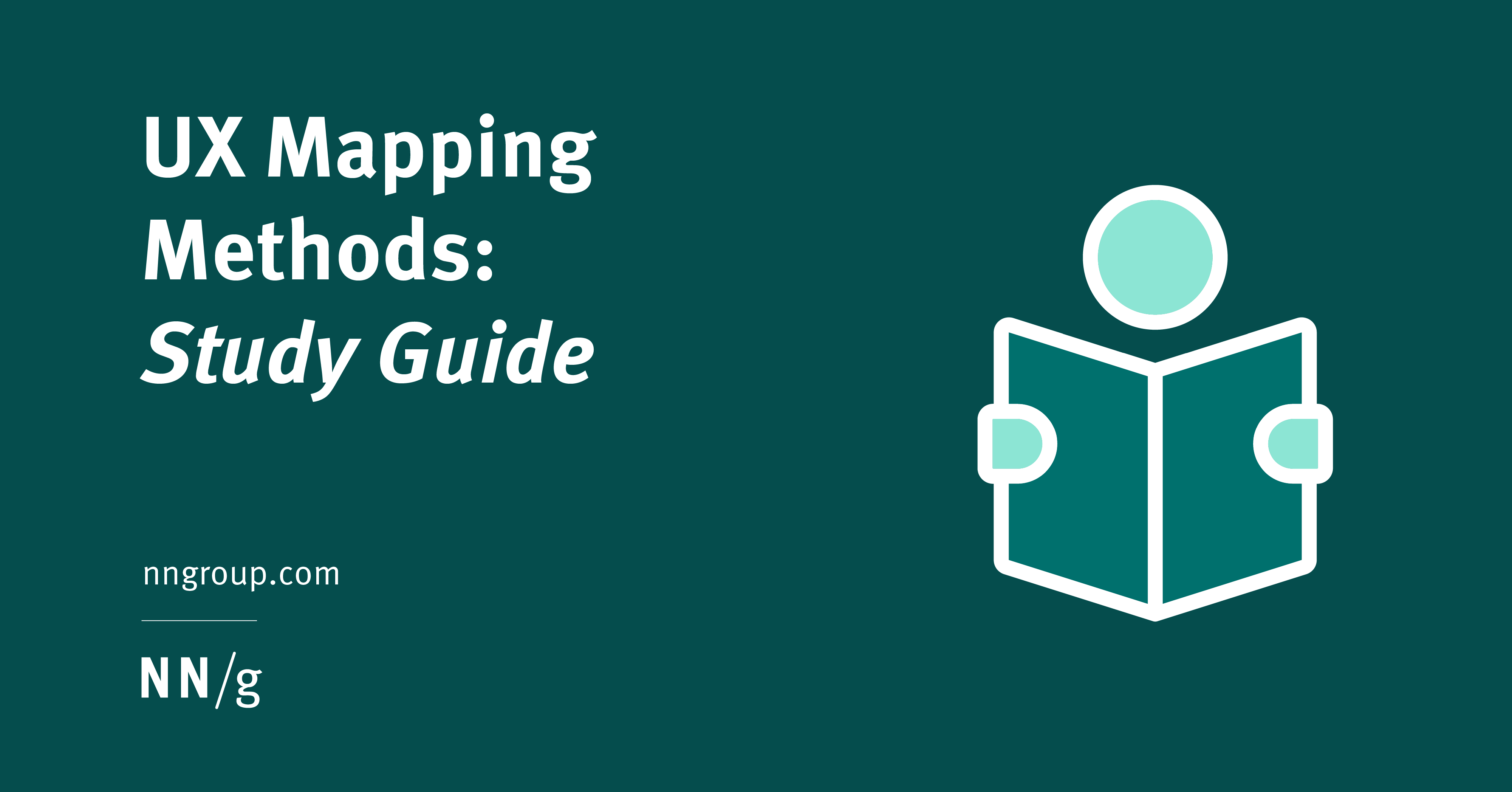Purpose: Customer Journey Mapping is a visual tool that helps teams understand how users experience a product or service across touchpoints over time.
Design Thinking Phase: Empathise
Time: 45–60 min session + 1–2 hours analysis
Difficulty: ⭐⭐
When to use:When aligning cross-functional teams on user pain points early in discoveryWhen optimising existing flows based on research insightsWhen designing new services with multiple touchpoints or channels
What it is
Customer Journey Mapping (also known as Experience Mapping) is a UX methodology that visualises the entire path a user takes when interacting with a product or service. It includes actions, thoughts, emotions, channels, and pain points at every step — enabling teams to design more coherent and meaningful experiences.
📺 Video by NNgroup. Embedded for educational reference.
Why it matters
Designers often see moments in a flow — but users live through entire journeys. Without mapping those journeys, it's easy to miss key frustrations, drop-offs, or unmet needs that occur across silos or time. Journey maps help teams break out of internal structures and see the product through the user’s lens. When done well, they drive alignment, prioritise features more meaningfully, and enable consistent end-to-end experiences.
When to use
- When you have foundational research but want to synthesise insights at a service level
- When multiple teams touch different parts of the user experience and need to align
- When preparing for a Service Blueprint or UX redesign
Benefits
- Rich Insights: Helps uncover user needs that aren’t visible in metrics.
- Flexibility: Works across various project types and timelines.
- User Empathy: Deepens understanding of behaviours and motivations.
How to use it
- Define the scope: Choose a specific persona and goal (e.g. “Booking a consult as a first-time home buyer”).
- Map journey stages: Identify broad steps in the path (e.g. awareness, consideration, action).
- Add user actions, emotions, and touchpoints: Use research to fill in real behaviours and perceptions.
- Highlight pain points and drop-offs: Mark where users feel confusion, frustration, or blockers.
- Discuss with your team: Align on opportunities, moments of delight, and service gaps.
- Export, share, and link to strategic artefacts like blueprints or roadmaps.
Example Output
A simplified customer journey map for a fictional fintech product:
| Stage | Action | Emotion | Touchpoint | Pain Point |
|---|---|---|---|---|
| Discovery | Searches for budgeting tools | Curious, cautious | Google, app store | Confused by inconsistent reviews |
| Onboarding | Downloads and sets up profile | Hopeful, slightly overwhelmed | App interface | Too many options upfront |
| Usage | Adds first few expenses | Energised | Mobile, email | Delayed sync with bank account |
| Retention | Checks weekly emails | Informed, motivated | Push notifications, email | Lacks personalisation |
Common Pitfalls
- Skimming research: A map is only as good as the data behind it. Ground your work in real user quotes and observed behaviour.
- Too generic: Avoid mapping with “average” users. Focus on one persona or situation per map to make it actionable.
- Not shared: Journey maps stuck in private decks won’t drive impact. Schedule a readout session and link maps to roadmap decisions.
10 Design-Ready AI Prompts for Customer Journey Mapping – UX/UI Edition
How These Prompts Work (C.S.I.R. Framework)
Each of the templates below follows the C.S.I.R. method — a proven structure for writing clear, effective prompts that get better results from ChatGPT, Claude, Copilot, or any other LLM.
C.S.I.R. stands for:
- Context: Who you are and the UX situation you're working in
- Specific Info: Key design inputs, tasks, or constraints the AI should consider
- Intent: What you want the AI to help you achieve
- Response Format: The structure or format you want the AI to return (e.g. checklist, table, journey map)
Level up your career with smarter AI prompts.Get templates used by UX leaders — no guesswork, just results.Design faster, research smarter, and ship with confidence.First one’s free. Unlock all 10 by becoming a member.
Prompt Template 1: “Map a User Journey for a First-Time Feature Experience”
Map a User Journey for a First-Time Feature Experience
Context: You are a UX designer exploring how new users interact with a recently launched feature in a productivity app.
Specific Info: The feature includes a multi-step setup, optional integrations, and shows varying completion rates across use cases.
Intent: Identify key friction points and emotional touchpoints to inform design improvements.
Response Format: Structure the output as a table with columns: Step, Action, Thought, Emotion, Barrier, Suggestion.
If any flow step or use context is unclear, ask clarifying questions.
Then, suggest one idea to validate assumptions with real users.
Prompt Template 2: “Turn Interview Notes into Journey Stages”
Turn Interview Notes into Journey Stages
Context: You are a UX researcher synthesising user interviews for a B2B onboarding experience.
Specific Info: You have notes from 8 calls, with timestamps and emotional cues, but no pre-set framework.
Intent: Convert qualitative notes into a structured customer journey with key phases marked.
Response Format: Summarise interview observations into journey stages with headings, quotes, and inferred pain points.
Ask for a sample transcript segment if you'd like more context before mapping.
Then, suggest a way to visualise this for cross-team alignment.
Prompt Template 3: “Generate Pain Point Hypotheses Across the Journey”
Generate Pain Point Hypotheses Across the Journey
Context: You are a senior designer preparing to audit the sign-up to trial conversion experience in a SaaS product.
Specific Info: Behavioural analytics show a major drop-off after the pricing page; no qualitative insight yet.
Intent: Forecast likely user pain points across the journey, to prioritise further research.
Response Format: Propose 3–5 distinct hypotheses with associated journey stages and suggested validation methods.
If the business goal or audience segment is unclear, ask that first.
Then, suggest which team member should be involved next.
Prompt Template 4: “Identify Journey Moments with Emotional Impact”
Identify Journey Moments with Emotional Impact
Context: You are designing for a wellness platform where motivation and habit formation are key to retention.
Specific Info: Usage data shows most churn happens between days 3–7.
Intent: Spot emotionally significant moments in the early journey where design can reinforce positive behaviour.
Response Format: Table with columns for Event, Likely Emotion, Design Opportunity, and Risk.
Ask clarifying questions if emotional intent isn’t clear.
Then, recommend a motivational trigger to test.
Prompt Template 5: “Workshop Prep: Frame Journey Questions for a Cross-Functional Sprint”
Workshop Prep: Frame Journey Questions for a Cross-Functional Sprint
Context: You are running a sprint involving PMs, designers, CS, and marketing.
Specific Info: The team is focused on reducing NPS complaints about the onboarding experience.
Intent: Prepare 5 thoughtful open-ended questions to explore customer journey gaps.
Response Format: List the questions, each with a note on how it reveals opportunity.
Ask for context if the NPS themes or user quotes are vague.
Then, suggest one question to ask leadership before kickoff.
Prompt Template 6: “Create Journey-Based Personas from Support Tickets”
Create Journey-Based Personas from Support Tickets
Context: You are analysing customer support data looking for patterns to inform new personas.
Specific Info: You've clustered 300+ support tickets by themes (e.g. account access, billing).
Intent: Build personas grounded in real journey issues, not just demographics.
Response Format: For each persona, include their pain points, goals, tool usage, and emotional tone.
Let me know if you’d like a ticket sample to test.
Then, suggest one way to validate these personas with product teams.
Prompt Template 7: “Translate Journey Insights into Feature Ideas”
Translate Journey Insights into Feature Ideas
Context: You are reviewing a journey map for an e-commerce returns process.
Specific Info: The map shows high anxiety post-return, with uncertainty around refund timelines.
Intent: Ideate ways to improve this journey stage with helpful features or comms.
Response Format: List 3–5 feature ideas with purpose, impact, and blockers.
Ask clarifying questions if the journey map lacks key events.
Then, propose a low-risk experiment to test one idea.
Prompt Template 8: “Summarise Cross-Channel Fragmentation in a Journey”
Summarise Cross-Channel Fragmentation in a Journey
Context: You’re working on an omni-channel service for a healthcare provider.
Specific Info: Patients move between a mobile app, web login, and phone support.
Intent: Highlight where users experience disruption when switching channels.
Response Format: Table with Journey Step, Channel, Friction, and Suggested Unification Ideas.
Ask for a touchpoint list if channels are unclear.
Then, propose one next step to align engineering and CX.
Prompt Template 9: “Enrich Journey Maps with User Quotes”
Enrich Journey Maps with User Quotes
Context: You are finalising a journey map from usability test sessions.
Specific Info: You have transcripts tagged by task and timestamp, but the map lacks empathy elements.
Intent: Pull compelling user quotes that clarify emotional experience per journey stage.
Response Format: Return quotes grouped by stage, with emotion tags and quote attribution.
Ask for quote length preferences or sentiment focus if needed.
Then, suggest a visual cue to present these quotes effectively on the map.
Prompt Template 10: “Audit Journey Maps for Bias or Assumptions”
Audit Journey Maps for Bias or Assumptions
Context: You joined mid-project and received a high-level journey map from another vendor team.
Specific Info: The map lacks data sources and shows overly happy-path flows.
Intent: Spot where assumptions may be hiding and reduce bias in interpretation.
Response Format: Annotate the map stages with potential assumptions or gaps, plus data types to validate.
Ask for project goals if context is missing.
Then, suggest how to reframe one journey stage to increase inclusivity.
Recommended Tools
- UXPressia – Visual journey mapping and persona builder
- Miro – Real-time collaboration for mapping workshops
- Dovetail – Repository for tagging interviews and linking quotes to maps
- Lucidchart – Diagrams with stakeholder-friendly outputs
- JourneyMap.ai – AI-powered journey visualisation and synthesis

Learn More







